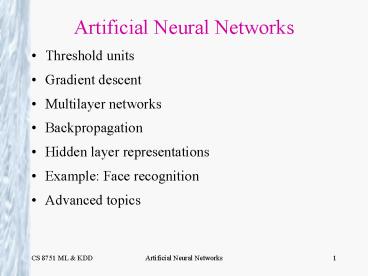Threshold units PowerPoint PPT Presentation
Title: Threshold units
1
Artificial Neural Networks
- Threshold units
- Gradient descent
- Multilayer networks
- Backpropagation
- Hidden layer representations
- Example Face recognition
- Advanced topics
2
Connectionist Models
- Consider humans
- Neuron switching time .001 second
- Number of neurons 1010
- Connections per neuron 104-5
- Scene recognition time .1 second
- 100 inference step does not seem like enough
- must use lots of parallel computation!
- Properties of artificial neural nets (ANNs)
- Many neuron-like threshold switching units
- Many weighted interconnections among units
- Highly parallel, distributed process
- Emphasis on tuning weights automatically
3
When to Consider Neural Networks
- Input is high-dimensional discrete or real-valued
(e.g., raw sensor input) - Output is discrete or real valued
- Output is a vector of values
- Possibly noisy data
- Form of target function is unknown
- Human readability of result is unimportant
- Examples
- Speech phoneme recognition Waibel
- Image classification Kanade, Baluja, Rowley
- Financial prediction
4
ALVINN drives 70 mph on highways
5
Perceptron
6
Decision Surface of Perceptron
- Represents some useful functions
- What weights represent g(x1,x2) AND(x1,x2)?
- But some functions not representable
- e.g., not linearly separable
- therefore, we will want networks of these ...
7
Perceptron Training Rule
8
Gradient Descent
9
Gradient Descent
10
Gradient Descent
11
Gradient Descent
12
Gradient Descent
13
Summary
- Perceptron training rule guaranteed to succeed if
- Training examples are linearly separable
- Sufficiently small learning rate h
- Linear unit training rule uses gradient descent
- Guaranteed to converge to hypothesis with minimum
squared error - Given sufficiently small learning rate h
- Even when training data contains noise
- Even when training data not separable by H
14
Incremental (Stochastic) Gradient Descent
Batch mode Gradient Descent Do until satisfied
Incremental mode Gradient Descent Do until
satisfied - For each training example d in D
Incremental Gradient Descent can approximate
Batch Gradient Descent arbitrarily closely if h
made small enough
15
Multilayer Networks of Sigmoid Units
16
Multilayer Decision Space
17
Sigmoid Unit
18
The Sigmoid Function
Sort of a rounded step function Unlike step
function, can take derivative (makes learning
possible)
19
Error Gradient for a Sigmoid Unit
20
Backpropagation Algorithm
21
More on Backpropagation
- Gradient descent over entire network weight
vector - Easily generalized to arbitrary directed graphs
- Will find a local, not necessarily global error
minimum - In practice, often works well (can run multiple
times) - Often include weight momentum a
- Minimizes error over training examples
- Will it generalize well to subsequent examples?
- Training can take thousands of iterations --
slow! - Using network after training is fast
22
Learning Hidden Layer Representations
23
Learning Hidden Layer Representations
24
Output Unit Error during Training
25
Hidden Unit Encoding
26
Input to Hidden Weights
27
Convergence of Backpropagation
- Gradient descent to some local minimum
- Perhaps not global minimum
- Momentum can cause quicker convergence
- Stochastic gradient descent also results in
faster convergence - Can train multiple networks and get different
results (using different initial weights) - Nature of convergence
- Initialize weights near zero
- Therefore, initial networks near-linear
- Increasingly non-linear functions as training
progresses
28
Expressive Capabilities of ANNs
- Boolean functions
- Every Boolean function can be represented by
network with a single hidden layer - But that might require an exponential (in the
number of inputs) hidden units - Continuous functions
- Every bounded continuous function can be
approximated with arbitrarily small error by a
network with one hidden layer Cybenko 1989
Hornik et al. 1989 - Any function can be approximated to arbitrary
accuracy by a network with two hidden layers
Cybenko 1988
29
Overfitting in ANNs
30
Overfitting in ANNs
31
Neural Nets for Face Recognition
90 accurate learning head pose, and
recognizing 1-of-20 faces
32
Learned Network Weights
33
Alternative Error Functions
34
Recurrent Networks

